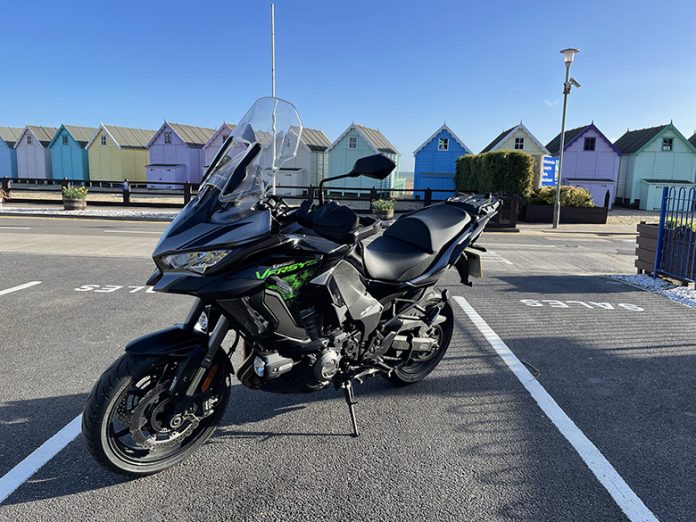With a 1,043cc engine, an active chassis, and comfort, this vehicle is the center of efficiency and utility. On any road, at any time, ride a motorbike that is as reliable as it is pleasant. The 1043cc inline four-cylinder engine, straight ride posture, integrated riding modes, Kawasaki Quick Shifter (KQS), multi-function TFT color LCD screen, electronic cruise control, and heated grips are all standard on the 2022 Versys 1000 LT SE.
The Versys 1000 LT SE combines a thrilling ride with motorbike touring capabilities, allowing riders to navigate any route.
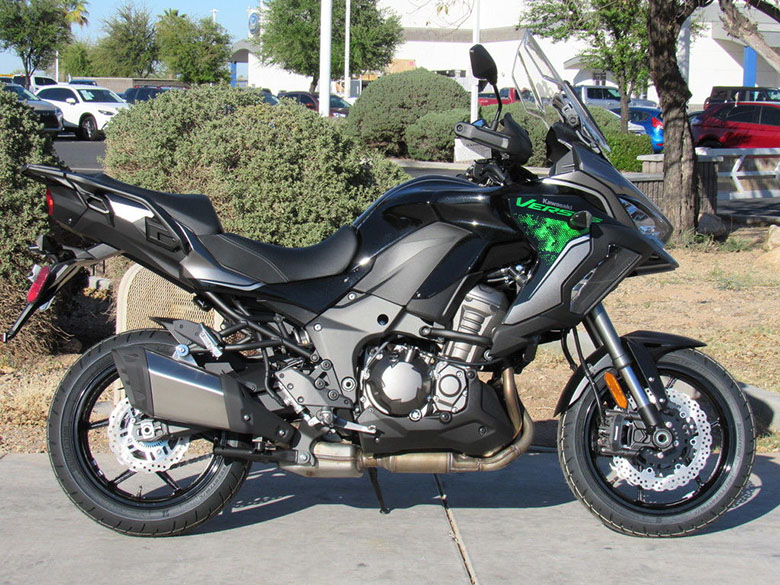
2022 Kawasaki Versys 1000 LT Touring Motorcycle – Features and Specs
Assist & Slipper Clutch
The Assist & Sleeper Clutch combines two types of cams (an assist cam and a sleeper cam) to hold the clutch hub and the operation plate together or separately, based on racing action data.
The assist cam acts as a self-serving mechanism in regular operation, pulling the clutch hub and operating plate together and compressing the clutch plates. It reduces the overall load of the clutch spring, resulting in a lighter clutch lever when using the clutch.
Economical Riding Indicator
Kawasaki models can reach the highest fuel efficiency level thanks to the management of high-precision electronic engines. Throttle usage, gear selection, and other factors controlling the rider, however, significantly affect fuel consumption. The Economical Riding Indicator is a feature that shows when current riding conditions are using petrol. The device continuously analyzes fuel usage regardless of vehicle speed, engine speed, throttle position, or other riding conditions. An “ECO” indicator appears on the instrument panel’s LCD screen when the fuel consumption for a particular speed is low (i.e., the fuel efficiency is high). Fuel consumption can be reduced by riding with the “ECO” signal on.
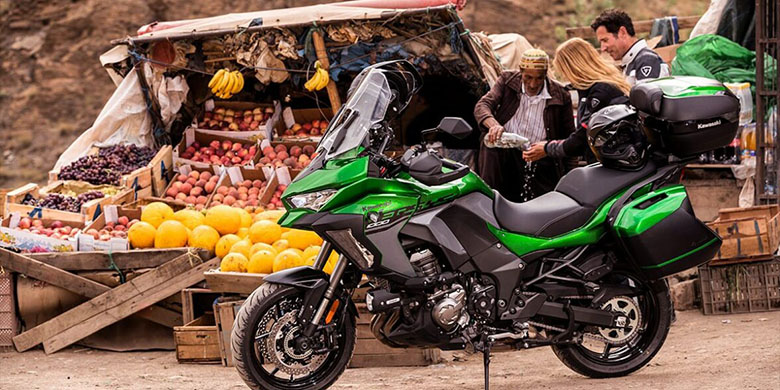
Electronic Cruise Control
Electronic cruise control lets you maintain a fixed speed (engine RPM) at the push of a button. Once activated, the rider does not need to use the throttle continuously. When traveling long distances, it relieves tension on the right-hand side, making walking and riding easier.
Electronic Throttle Valves
The ECU, with Kawasaki’s fully electronic throttle activation system, can manage the volume of both fuel (through fuel injectors) and air (through throttle valves) delivered to the engine. Smooth, natural engine response and optimal engine performance are achieved by excellent fuel injection and throttle valve position. Technology also plays a significant role in reducing emissions.
KTRC (Kawasaki Traction Control)
KTRC, Kawasaki’s innovative traction control technology, improves sports riding performance and gives you peace of mind while discussing slippery conditions. Multiple rider selectable modes (the number of methods varies depending on the model) provide a gradual high level of interference depending on the riding conditions and the rider’s desire.
Less invasive settings keep traction at bay when cornering. They’re designed with sport riding in mind, and they help you accelerate out of turn by increasing the rear wheel forward drive. Kawasaki’s advanced software can consider corner camber, gradient, and other factors as it focuses its dynamic analysis on the chassis orientation relative to the track surface (rather than the horizontal plane).
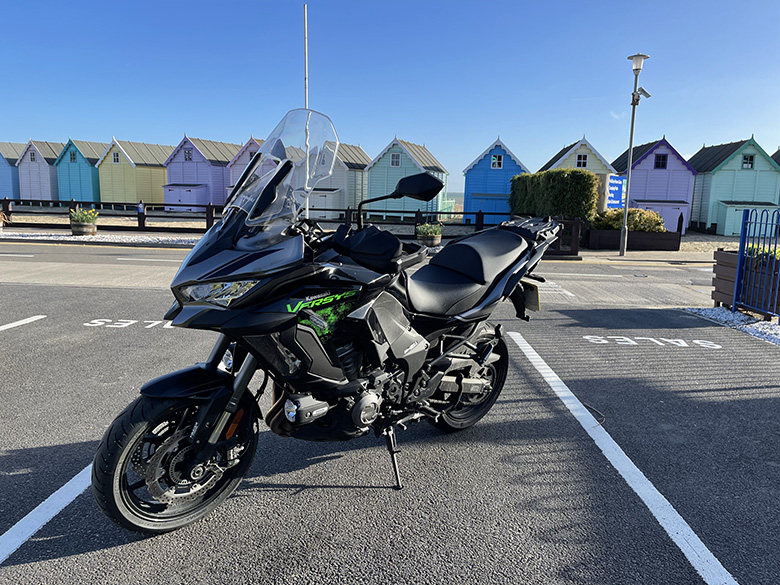
Power Modes
Models with multiple power modes provide the riders with easily selected engine power delivery according to their riding conditions or preferences. In addition to the full power mode, one (low) or two (medium, inferior) additional methods limit the maximum power and soften the throttle response.
KCMF (Kawasaki Cornering Management Function)
KCMF carefully monitors engine and chassis parameters throughout the corner – from entry to exit – to facilitate high-speed braking and smooth transition to the remodified brake force and engine power. It also helps riders locate their desired line.
Horizontal Back-link Rear Suspension
Compared to Kawasaki’s distinctive Uni-Trak rear suspension, which mounts the shock unit vertically, the shock unit is practically horizontal with Horizontal Back-link Rear Suspension. The shock unit is located close to the motorcycle’s center of gravity in the original Kawasaki suspension setup, which significantly aids in large-scale centralization. Since there is no connection or shock unit behind the swing arm, space is provided for a larger exhaust pre-chamber (an exhaust expansion chamber located just above the silencer). The silencer volume can be reduced with a larger pre-chamber, and heavier exhaust components can be focused closer to the motorcycle’s center, which helps in more excellent centralization. As a result, handling has dramatically improved.
KIBS (Kawasaki Intelligent Anti-Lock Brake System)
Kawasaki has designed the KIBS to accommodate the supersport bike’s unique handling features, which provide highly efficient brakes with little interference during the ride. The ABS ECU (Electronic Control Unit) and the engine ECU are connected for the first time in a mass-production brake system.
The KIBS front brake caliper measures front and rear wheel speeds in addition to hydraulic pressure, throttle position, engine speed, clutch activation, and gear position. To establish the proper front brake hydraulic pressure, all this data is checked.
IMU-Enhanced Chassis Orientation Awareness
The highly sophisticated programming that offers the ECU an accurate picture of what the chassis is doing has always been the power of Kawasaki’s state-of-the-art electronics. The Magic Formula tire model is used skillfully through Kawasaki’s dynamic modeling program as it monitors changes in many parameters, allowing it to track changing road and tire conditions.
Installation of IMU (Inertial Measurement Unit) allows monitoring of inertia with 6 DOF (Degree of Independence). Speed is recorded along the longitudinal, transverse, and vertical axes, as well as the roll and pitch rates.
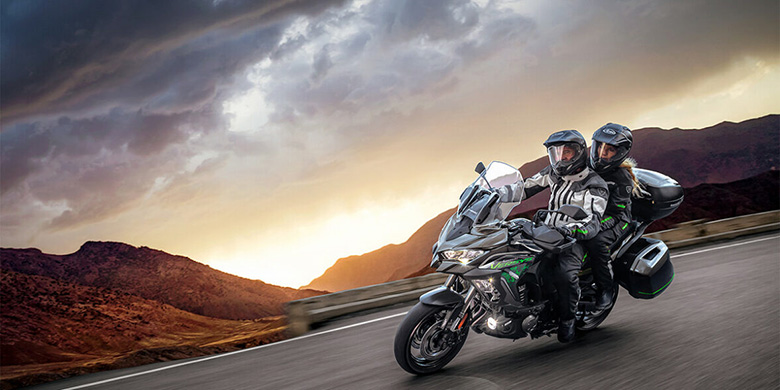
2022 Kawasaki Versys 1000 LT Touring Motorcycle – Technical Specifications
Power
| Engine | 1,043cc, liquid-cooled, 4-stroke, DOHC 16-valve in-line four |
| Bore x Stroke | 77.0 x 56.0 mm |
| Compression Ratio | 10.3:1 |
| Fuel System | Fuel injection: ø38 mm x 4 |
| Ignition | Digital |
| Starting | Electric |
| Lubrication | Forced lubrication, wet sump |
| Transmission | 6-speed, return |
| Clutch | Wet multi-disc, manual |
| Final Drive | Chain |
Performance
| Frame | The twin tube, aluminum |
| Front Suspension / Wheel Travel | ø43 mm inverted fork including rebound damping (right-side) and spring preload adjustability / 150 mm (5.9 in) |
| Rear Suspension / Wheel Travel | Horizontal Back-link, gas-charged shock including rebound damping and remote spring preload adjustability / 152 mm (6.0 in) |
| Rake / Trail | 27.0° / 106 mm |
| Steering Angle (L/R) | 34° / 34° |
| Front Tire | 120/70ZR17M/C (58W) |
| Rear Tire | 180/55ZR17M/C (73W) |
| Front Brakes | Dual semi-floating ø310 mm petal discs with radial-mount, monobloc, opposed 4-piston calipers |
| Rear Brake | ø250 mm petal disc with single-piston caliper |
Details
| Dimensions (L x W x H) | 2,270 x 895 x 1,465/1,400 mm |
| Wheelbase | 1,520 mm (59.8 in) |
| Road Clearance | 150 mm (5.9 in) |
| Seat Height | 840 mm (33.1 in) |
| Curb Mass | 253 kg (558 lb) without saddlebags |
| Fuel Capacity | 21 liters |
| Instrumentation | Analog-style tachometer + full-digital LCD screen with digital speedometer, dual trip meters, gear position indicator, fuel gauge, current and average fuel consumption, odometer, remaining range, bank angle display, and the max bank angle recording function, coolant temperature, intake air temperature, clock, Economical Riding Indicator and IMU indicator |
| Warranty | 24 months |
| Kawasaki Protection Plus | 12 / 24 / 36 / 48 months |

